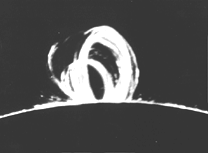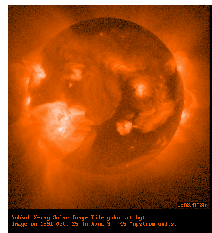|
[an error occurred while processing this directive]
#17. The Sun's Corona
|
(Files in red–history) |
 During a total eclipse of the Sun, when for a few minutes the Moon completely covers the Sun's face, a glow appears around the darkened Sun--the solar corona, the Sun's outermost atmosphere. Structures visible in the corona at such times suggest that they are shaped by magnetic fields, and therefore, that the corona consists of plasma. For instance, short "plumes" rising from the polar regions of the Sun look very much like field lines coming out of the end of a bar magnet, and they therefore suggest that the Sun, in addition to the intense fields of sunspots, also has a global magnetic field like the Earth's.
Structures observed in the corona above sunspots often have horseshoe-shaped outlines, again suggesting that they follow magnetic field lines. From the tops of such "arches" long streamers may extend, to distances of the Sun's diameter or even more, looking like pulled taffy, as if some process was pulling material away from the tops of the arches into space, (which is of course what the solar wind actually does). Astronomers have named them "helmet streamers" because of their resemblance to spiked helmets worn by knights (and also to those used by some German soldiers up to 1918).
|
The High Temperature of the Corona
|
XThe most remarkable aspect of the corona is its high temperature, deduced by the Swedish astronomer Bengt Edlen in 1942 after a study of the corona's light. Much of that is sunlight scattered by coronal dust, but some light is also produced by the corona itself, in narrowly defined colors ("spectral lines") characteristic of its emitting atoms. In the 19th century, some of the spectral lines of sunlight did not match the lines of any substance on Earth, and it was proposed that they came from a new unknown chemical element, named helium (from the Greek helios--Sun). Later, in 1895, William Ramsey actually discovered helium on Earth. Unknown spectral lines emitted by the corona were similarly credited to a new element "coronium" until Edlen showed that they came from the familiar atoms of iron, nickel and calcium, after they had lost an appreciable number of electrons (e.g. 13 or 14 for iron). Such high levels of ionization require the atoms to be buffeted around by extremely high temperatures, around 1,000,000 C (1,800,000 F). The source of the corona's heat remains a puzzle. It is almost certain that its energy comes from the Sun's internal furnace, which also supplies the rest of the Sun's heat. However, as a rule, temperatures are expected to drop the further one gets from the furnace, whereas the million-degree corona lies outside the surface layer where sunlight originates, whose temperature is less that 6000 C.
|
|
A more detailed discussion of solar observations in x-rays, titled "Seeing the Sun in a New Light," can be found in the sister-site "From Stargazers to Starships."
Questions from Users: *** Questions about the Solar Corona: (1) Why don't its particles separate by weight? (2) What accelerates the solar wind? *** Sound waves on the Sun? |
Next Stop: #18. The Solar Wind
- Back to the Index Page
Timeline Expanded timeline Glossary
Author and Curator: Dr. David P. Stern
Mail to Dr.Stern: education("at" symbol)phy6.org
Co-author:
Dr. Mauricio Peredo
Spanish translation by J. Méndez
Re-formatted 3-13-06


